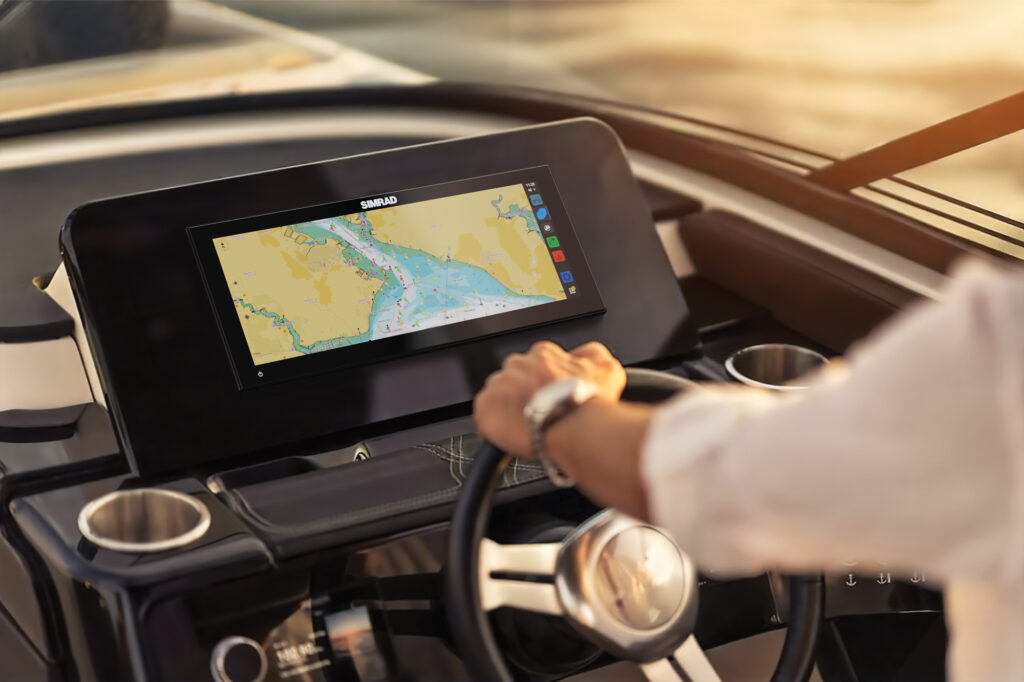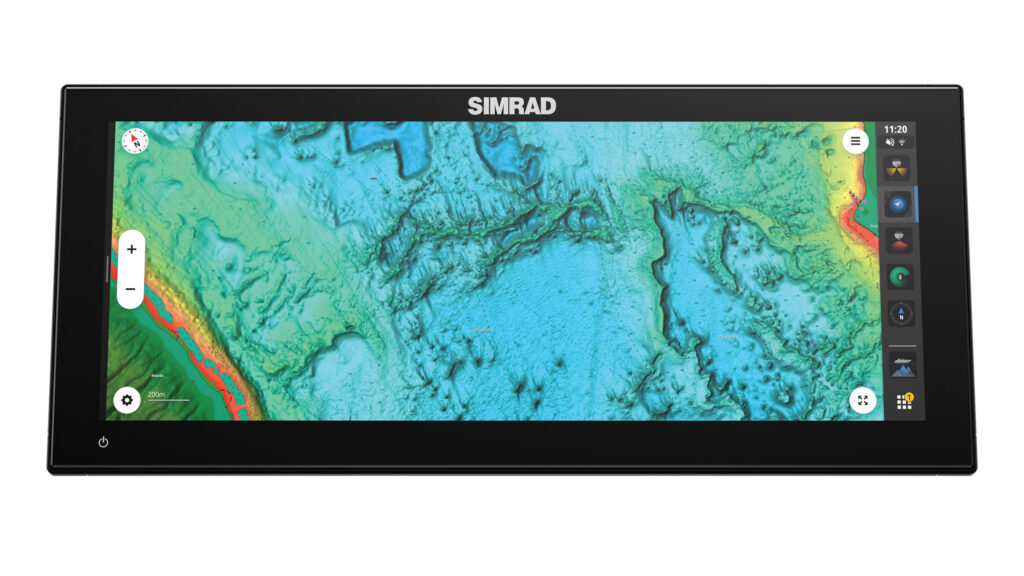
For years, I ran dual monitors on my desk: one for email and web browsing, and the other for writing. This setup worked fine, but the separation between screens—measured only in inches—disrupted my workflow. Then a friend persuaded me to get a single 27-inch Apple Cinema Display, and my work life improved. My eyes no longer had to perform sideways somersaults, and the setup looked cleaner.
Almost 15 years later, similar thinking has reached multifunction displays. While ultrawide displays have existed in vehicles and offices for years, Simrad’s NSX Ultrawide is the first fully featured multifunction marine display from a major manufacturer to use a widescreen format. Its shape is akin to running two smaller side-by-side screens, letting yacht designers and owners reimagine helm and flybridge configurations. Price tags are a click astern of Simrad’s flagship displays, bringing the ultrawide option into range for more boaters.
NSX Ultrawide displays come in 12 and 15 inches. The 12-inch display ($2,900) measures 13.3-by-5.82 inches, while the 15-inch model ($3,550) is 15.55-by-6.71 inches. Stephen Thomas, Simrad’s product director for digital systems, says boaters can think of the 12-inch displays as being the equivalent of two 7-inch Simrad screens, while the 15-inch display is like two 9-inch screens.
“Customers have been asking for this format,” Thomas says. “Boat designers take their cues from the automotive industry. The trend has been coming for a long time.”
Automotive and marine screens share many environmental requirements, including the ability to survive wide temperature ranges. The challenge, Thomas says, was finding a screen that met boaters’ needs and could then use Simrad’s existing software to control it.

Thomas says the displays aren’t vying for top-dog status within Simrad’s product pantheon. While NSX Ultrawide displays use the same screen technology (including in-plane switching) as Simrad’s flagship products, they use slower, less-powerful quad-core processors and a different operating system. NSX Ultrawide displays also have comparably limited sonar capabilities.
The advancements are the screens’ shape and the places they can go, Thomas says: “Certainly, moving to the NSX Ultrawide with the Neon operating system gives [customers] access to a better charting experience because we support C-Map’s Discover X format. It’s an all-vector-based charting system, and it just scales better.”
Critically, these displays can interrogate the information within their vector cartography (say, bathymetric data) to generate onscreen C-Map safety alerts. “It’s another layer of safety so you know you’re not headed into [dangerous] areas,” Thomas says.
The screen was officially unveiled earlier this year at the Miami International Boat Show, where boatbuilders had installed NSX Ultrawide displays on nine new boats.
“I see it changing helm design,” Thomas says. “I think above the helm, or places where people want access to information, but they don’t necessarily need access to it front and center all the time.”
NSX Ultrawide displays support customizable screen views and instrument panels, and the activities sidebar makes it easy to switch applications. While an over-the-helm NSX Ultrawide display won’t replace the yacht’s main multifunction display, it could be a dedicated, task-specific addition. For example, skippers could dedicate an over-the-helm NSX Ultrawide to engine and engine-room monitoring, or to instrument data.
Another possibility is that the displays could allow yacht designers (or yacht owners doing refits) to lower flybridge helms or dashes, enhancing the skipper’s field of view. “There are industry standards that dashes can’t exceed certain heights,” Thomas says, adding that with the NSX Ultrawide, a lower dash could still “give the consumer an experience where it’s easy to see and to operate the screen.”
Thomas also says designers and vessel owners could add touchscreen glass to areas that were previously clad with fiberglass or wood veneer. “It’s another tool in the toolbox,” he says.
Bigger ultrawide-format screens could be in the offing. This could be especially interesting if Simrad released a widescreen display with the company’s best processors and sonar capabilities. For now, however, the displays are proving popular with boaters who are swapping out two older, smaller screens for a single NSX Ultrawide display. “It comes down to an aesthetic preference for what looks better,” he says.
Given the screens’ relatively modest size and price, they also can serve as the main glass aboard tenders and side rides. For yacht designers or owners contemplating new builds or refits, the possibilities can be significant.
As for my office, my sole regret was that I bought a single 27-inch Apple Cinema Display, not two. Given the size and screen formats of contemporary monitors, that’s a price I plan to pay on my next refit.








